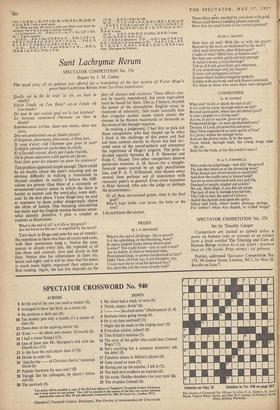Chess
fly PHILIDOR No. 102. A. G. MESCH1CK
BLACK (5 men) WII1TE (7 men)
wurrE to play and mate in two moves: solution next week. Solution to last week's problem by Baton: Q-B 4,'no threat. Theme of the tourney in which this won first prize was Black pawn moves interfering with actions of other pieces; here we have 1 . P-Q Kt 3; 2 Kt-Q 6. 1 . • P-Q Kt 4; 2 Q-I3 1. 1 . . . P-Q 3; 2 Q-K 6. 1 . . . P-Q 4; 2 R-K 5. 1 . . . P-K Kt 3; 2 Kt x R P. 1 . . . P-K Kt 4; 2 Kt-K 7. Other variations left to readers to work out.
When this article appears play will have started in two of the three European zonal tournaments—the first stage in the series of tournaments to produce a 1960 challenger for Smyslov's newly acquired world title. British players have no direct interest in the Sofia tournament, but at Dublin, where play started on May 12, Alexander is representing the British Chess Federation and Fairhurst the Scottish. There are eighteen competitors in all from East and West Europe, with a South African (Dreyer) for good measure; my forecast for first three places (and qualifying for the 1958 interzonal tournament) arc Gligoric, Pachman and Schmid. I hope to give some games from the Dublin tournament in the next few weeks: meanwhile here is an amusing game from the counties correspond- ence championship.
White, C. W. Fatows Black, B. H. WOOD
'(Northumberland) (Warwickshire)
Opening, Scotch Four Knights.
I P-K 4 P-K 4 11 K-Q 1 Kt x R
1 Kt-K 83 Kt-Q 03 12)' x Kt P-B 3(4) 3 Kt-B 3 Kt- B 3 13 P x P P x kt 4 P-Q 4 P x P 14 11-0 3 Q-13 3 tel
5 Kt-Q 5 (a) Kt x P(b) 15 R-K 1 ch B-K 24r)
6 (:)-K 2 P-K 11 4 16 P x P E-Q 3 Oa 7 Kt-Kt 5 P-Q 6 17 P-K1 7 0 x E
Sr x 11 X:-QS 18-9-R 5 ch K-11 1 (h)
9 Q-R 5 ch P-Kt 3 19 kt-K 6 ch 11 x Kt
10 Q-R 4 1(1-11 7 ch?(c) 20 R x It (i) Ro.igns (I) (a) This tricky line was introduced by the Yugoslav players, Black's safest reply is 5 . . . B-K 2; e.g. 6 B-Q 11 4, P-Q 3:
7 Kt X P, K Kt X Kt; 8 P X Kt, Kt X Kt; 9 Q X Kt, 0-0; 10 0-0-0, B-B 3 with a good game. (b) While not bad, this move is risky and Black must know the variation well if he is to play it without disaster. (c) Losing move. 10... P-B 3; LIP x Kt, I' x Kt; 12 P x BP, Kt x P gives equality. (rf) If 12 ... B-K 2; then 13 Q-R 61 or 12 ... B-Kt 2; 13 P x P,
111-K It 3; 14 Q-K 4 ch, K-B 1; 15 P x P or 12 . P-Q 3; 13 P x P, B x P; 14 B-Kt 5 ch, P-B 3; 15 R-K 1 ch.
(e) 14 B-K 2; 15 P x P and 16 P-Kt 7 or 14 ... B-Kt 2; 15 It-K 1 cb, K-B 1; 16 Kt x P ch.
(f) 15 ... K-Q 17; 16 Kt-B 7 ch. (g) 16... P x P; 17 B x P ch, K-Q 1; 180 x R cb! or 16
. P-K R3; 17 Q-R Sand now 17 . . . X-Q 1; 18 Kt-B 7 ch
or 17.. . P x Kt; 18 P-Kt 7 chi, x Q; 19 .13...Q ch, Q—B 1;
20 B-Kt 6 mate.
(h) 18 . K-Q 2; 19 Kt-K 61, Q macs; 20 B-Kt 5 mate. (I) Not 20 B-It 6?, B-Kt 5 eh! (/) 21 B-R 6 is threatened. If 20 ... Q-B 2; then 21 B-R 6 ch, K-K 1; 22 B-Kt 5 ch wins queen or 20 ... P-K R 3; 21 B x RI', R x B; 22 It x R, B-B 3; 23 11-11 7, Q-Kt 1; 24 Q-13 5 and wins. Fine game by Follows.



































 Previous page
Previous page